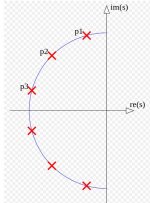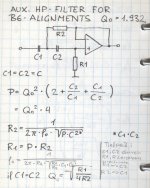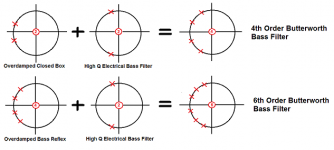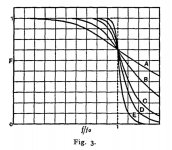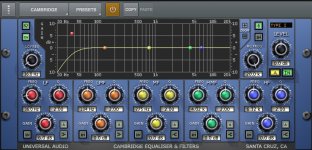I don't fully understand the relationship of the Q to the gain. I thought it only altered the range the gain was spread over? I'm taking an experimental approach and +6dB gain definitely ups the bass, while -6dB gain decreases it...
You're probably out of your depth here.
Those of us who understand filters know that a 6th Order Butterworth highpass looks like the below diagram except that there is a sixth order zero at the origin.
The reflex physical speaker poles correspond to p2 and p3 and the reflected poles below. The electrical filter corresponds to p1 and the reflected pole below.
The electrical p1 filter, by it's very closeness to the imaginary axis is a High Q filter. Probably around Q=2. I can't explain it more simply. This is deeply mathematical. Because the poles are on the l.h.s. of the axis, being a real world application, group delay is positive. The bass lags the main signal.
Attachments
Last edited:
... I'm not sure it's really worth the effort. If you think that closed box is second order, reflex generally 4th order at whatever steepness you fancy, then even steeper 6th order is pretty small beer in the overall scheme of things...
Well, I think it´s worth the effort and almost all modern active monitors use
some kind of B6 like alignment BTW (just have a look at the Genelec 8050 for
an example Genelec 8050B - Powerful Wideband Bi-Amplified Monitoring System ). Of course it will depend
on the kind of music, with a recording of a singer accompanied by an acoustical
guitar you might not notice a difference, a Mahler symphony is a different story.
I don't fully understand the relationship of the Q to the gain. I thought it only altered the range the gain was spread over? I'm taking an experimental approach and +6dB gain definitely ups the bass, while -6dB gain decreases it...
It seems that you have combined varoius filters with the software you mentioned.
For the alignment I described in http://www.diyaudio.com/forums/mult...ment-filter-b-w-matrix-805-a.html#post3480595
you use a second order high pass filter with Q of about 2 which gives you 20*log(Q) (+6dB) boost at the filters resonant frequency.
Have a look at Fig.2 here B&W Matrix 805 loudspeaker Measurements | Stereophile.com
The fourth order response of the (ported) loudspeaker system combined with the second order filter
gives you a sixt order response with lower f3.
I have attached an old (from the 80ties ;-) ) note of mine how to calculate such a filter.
For the B&W Matrix 805 you need a filter frequency f=36Hz with a Q=2.
Example for f=36Hz and Q=2:
C1=C2=100nF
R1=176.838826 kOhm
R2=11.052427 kOhm
To arrive at the calculated values you can paralell standard (used here E48) values :
for R1 316 kOhm paralell to 402 kOhm = 176.924791 kOhm
for R2 16.2 kOhm paralell to 34.8 kOhm = 11.054118 kOhm
Attachments
Last edited:
As well as Krell, a company called Anodyne also did an up-market version of the BAF and I have one for the 805.
Basically it's a similar small board but with better components and obviously none of the DIP switches are needed. 24v internal supply too.
I'll get it out and take some photos of the board etc perhaps over the weekend.
Basically it's a similar small board but with better components and obviously none of the DIP switches are needed. 24v internal supply too.
I'll get it out and take some photos of the board etc perhaps over the weekend.
I'm not sure it's really worth the effort. If you think that closed box is second
order, reflex generally 4th order at whatever steepness you fancy, then even
steeper 6th order is pretty small beer in the overall scheme of things.
Hi,
In the overall scheme of things you don't understand 6th order,
and how common it is and why for many vented subwoofers.
rgds, sreten.
Whilst it may be fun to show who knows what to the world, the OP just asked to copy the circuit of the BAF to make his own - no knowledge needed and that is about my level of DIY..
As I say, I have an aftermarket copy of the circuit so it can be copied and made by whomever wants to, knowledge of Butterworths or not.. no need to argue.
As I say, I have an aftermarket copy of the circuit so it can be copied and made by whomever wants to, knowledge of Butterworths or not.. no need to argue.
I think I DO understand what this approach is doing here, sreten, but I thank you for your comment. Using complex variable, the symmetries become very elegant.
If you want to build an active bass system, you may as well make the electrical filter as complex as you like to tie in with the physical speaker and enclosure. Opamp filters produce group delay, some digital techniques can be phase linear.
The B&W Matrix 805 is clearly doing something clever. My misgiving is that without the little box of tricks, it is merely an overdamped bass reflex. You would optimise it differently for normal use.
It is quite interesting to me that you could do something similar with closed box or even open baffle.
Now back to the discussion.
If you want to build an active bass system, you may as well make the electrical filter as complex as you like to tie in with the physical speaker and enclosure. Opamp filters produce group delay, some digital techniques can be phase linear.
The B&W Matrix 805 is clearly doing something clever. My misgiving is that without the little box of tricks, it is merely an overdamped bass reflex. You would optimise it differently for normal use.
It is quite interesting to me that you could do something similar with closed box or even open baffle.
Now back to the discussion.
Attachments
You will probably find that the alignment is of the sort found here...
Satellites and Subwoofers
rcw
Satellites and Subwoofers
rcw
I have attached an old (from the 80ties ;-) ) note of mine how to calculate such a filter.
For the B&W Matrix 805 you need a filter frequency f=36Hz with a Q=2.
Example for f=36Hz and Q=2:
C1=C2=100nF
R1=176.838826 kOhm
R2=11.052427 kOhm
It's been a while and I've come back to this after fiddling around with my speakers and amp again. Using the EqualizerAPO software I've added a high pass filter at 36Hz with Q=2. This makes a massive difference to the sound, improving the depth and volume of bass.
I don't understand alignment properly but surely, assuming the filter is coded precisely, this should mimic the BAF? Or does the BAF hardware include a gain element in addition to the high pass action?
The EQ that you used in the older post (a hump with a Q of 0.5) would give you probably less group delay than what you are using now, but you would not gain any driver protection. The least group delay would be added by using a shelving filter as EQ but that would give even less driver protection at subsonic frequencies.
The shelving EQ is attractive for sturdy woofers and the 6th order highpass variant (that you are currently using) is very attractive for small woofers.
For those who want to try a 6th order tuning with a driver of their choice the following approximation formulae may be used to calculate the tuning:
fb = f3 = fp = fs*0.3/Qts
Vb = 4.1 * Vas * Qts^2
fp = filter pole frequnecy, filter Q is 2
With this type of tuning the bass extension of woofers with a Q higher than 0.3 can be extend quite siginficantly at the cost of efficiency and maximum SPL.
Regards
Charles
The shelving EQ is attractive for sturdy woofers and the 6th order highpass variant (that you are currently using) is very attractive for small woofers.
For those who want to try a 6th order tuning with a driver of their choice the following approximation formulae may be used to calculate the tuning:
fb = f3 = fp = fs*0.3/Qts
Vb = 4.1 * Vas * Qts^2
fp = filter pole frequnecy, filter Q is 2
With this type of tuning the bass extension of woofers with a Q higher than 0.3 can be extend quite siginficantly at the cost of efficiency and maximum SPL.
Regards
Charles
It seems that you have combined varoius filters with the software you mentioned.
For the alignment I described in http://www.diyaudio.com/forums/mult...ment-filter-b-w-matrix-805-a.html#post3480595
you use a second order high pass filter with Q of about 2 which gives you 20*log(Q) (+6dB) boost at the filters resonant frequency.
Have a look at Fig.2 here B&W Matrix 805 loudspeaker Measurements | Stereophile.com
The fourth order response of the (ported) loudspeaker system combined with the second order filter
gives you a sixt order response with lower f3.
I have attached an old (from the 80ties ;-) ) note of mine how to calculate such a filter.
For the B&W Matrix 805 you need a filter frequency f=36Hz with a Q=2.
Sorry to revive this thread. I have a very lay-person question;
Would a butterworth 2nd order filter, such as the one below "B2" on UAD's Cambridge EQ, theoretically give me the same results as the BAF filter?
I do not need to boost the resonant frequency?
Thank you!
Attachments
Sorry to revive this thread. I have a very lay-person question;
Would a butterworth 2nd order filter, such as the one below "B2" on UAD's
Cambridge EQ, theoretically give me the same results as the BAF filter?
I do not need to boost the resonant frequency?
Thank you!
Hi,
Short answer is no. You do need boost. YMMV but 6th order
Butterworth is a recipe for bass boom, room and speaker
placement dependant. The above is just a sub filter.
rgds, sreten.
Hi, It looks like there are some very bright people in this forum. I can't find a BAF for my B&W Matrix 805's. I haven't read schematics for 20 years, but I still have my soldering iron. Can someone please speak to me in the more simple terms I need to be able to build one? I'm looking for quality and I'm willing to pay for the best components, so detailed descriptions that would help me find them would be great. Thank you in advance for your kind help. 
Cheers!
Cheers!
So I found this page:
B&W Bass Alignment Filter
On which I found this chart:
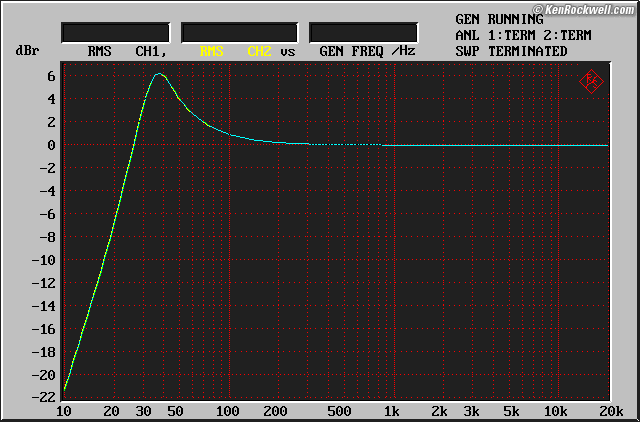
This should take like 30 seconds to do with miniDSP or just about any similar thing. It looks like a 4th order high pass filter with an extra bump at 36 Hz (per discussion) or maybe a 3rd with very high Q.
 QED.
QED.
B&W Bass Alignment Filter
On which I found this chart:

This should take like 30 seconds to do with miniDSP or just about any similar thing. It looks like a 4th order high pass filter with an extra bump at 36 Hz (per discussion) or maybe a 3rd with very high Q.
edwards,
This one should work:
https://www.minidsp.com/products/minidsp-in-a-box/minidsp-2x4-hd
You do not need the "advanced" plugin unless you want to add a sub. If you just want to replicate this curve, that should be all you need. If you want to do some EQ beyond that you should consider the microphone and Room EQ Wizard to help you.
Best,
Erik
This one should work:
https://www.minidsp.com/products/minidsp-in-a-box/minidsp-2x4-hd
You do not need the "advanced" plugin unless you want to add a sub. If you just want to replicate this curve, that should be all you need. If you want to do some EQ beyond that you should consider the microphone and Room EQ Wizard to help you.
Best,
Erik
Hi,
I'm sorry for my ignorance on this, but very thankful for the advice!
My focus for the system is music. My current setup is music sources to Arcam irDAC -> Marantz AV7005 -> Adcom amp -> B&W Matrix 805's. I don't have a sub due to close neighbors and WAF . Would the minidsp-2x4-hd go between the amp and preamp?
. Would the minidsp-2x4-hd go between the amp and preamp?
Overall I'm happy with the sound, but just want a bit tighter bass.
I've used the Audyssey setup in the Marantz, but I got more "boom" in the bass than definition. So, I'm running it in "Pure Direct" mode. It sounds best, but the bass is lacking.
Thanks,
I'm sorry for my ignorance on this, but very thankful for the advice!
My focus for the system is music. My current setup is music sources to Arcam irDAC -> Marantz AV7005 -> Adcom amp -> B&W Matrix 805's. I don't have a sub due to close neighbors and WAF
Overall I'm happy with the sound, but just want a bit tighter bass.
I've used the Audyssey setup in the Marantz, but I got more "boom" in the bass than definition. So, I'm running it in "Pure Direct" mode. It sounds best, but the bass is lacking.
Thanks,
Hi,
Thank you eriksquires!!! I went with the miniDSP-2x4-HD and that's NAILED IT. I dialed in the chart you showed and the improvement was surprising. It was better than expected. I have enough bass, but no "booming" to it. I can now distinguish the different bass notes and "color". I really appreciate your time, attention and expertise. With your help I'm a happy listener (at least for now...you know how this goes).
Cheers,
Thank you eriksquires!!! I went with the miniDSP-2x4-HD and that's NAILED IT. I dialed in the chart you showed and the improvement was surprising. It was better than expected. I have enough bass, but no "booming" to it. I can now distinguish the different bass notes and "color". I really appreciate your time, attention and expertise. With your help I'm a happy listener (at least for now...you know how this goes).
Cheers,
- Home
- Loudspeakers
- Multi-Way
- Bass Alignment filter for B&W Matrix 805
